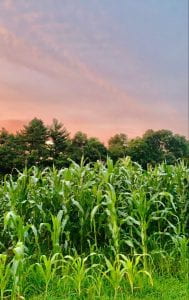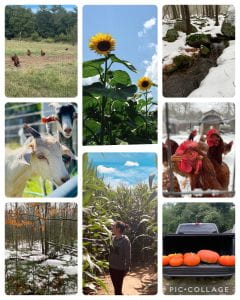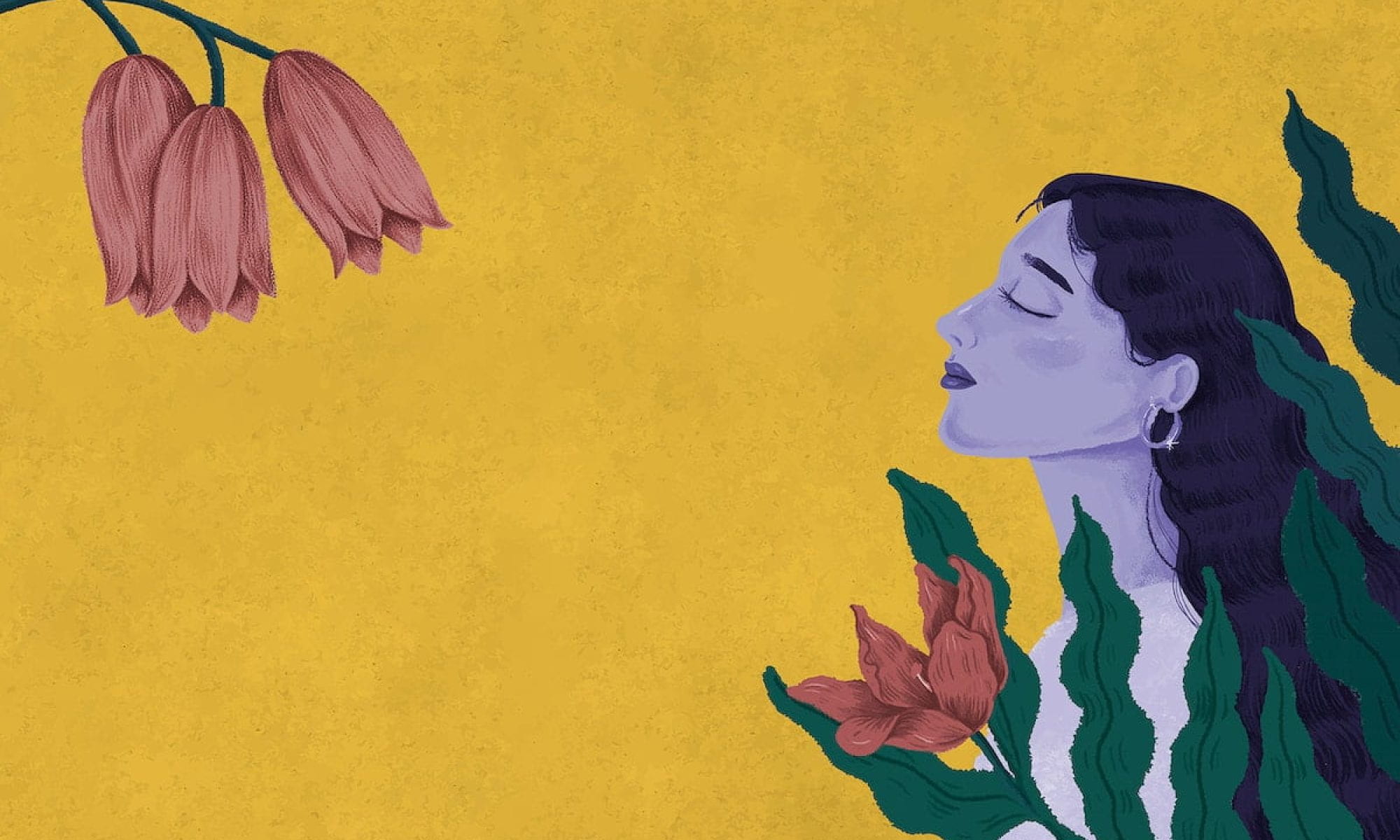Home to me feels like waking up to the sound of birds chirping, chickens clucking, and bugs hissing. Growing up in a rural town filled with farms and acreage of landscape, I consider myself connected with nature. You can drive for miles and see all the wonders that Earth provides, the resources that our capitalist society has commodified.
However, simply living amongst nature does not foster connection, but rather living in harmony and appreciation of the soil that lays beneath our feet informs us who we really are.
As a little girl I remember staring at the landscapes in awe of how such beauty can exist. As I got older, the land began to disappear more and more each year. Trees no longer housed the cardinals that would sing each morning but instead were clear cut to make way for endless housing developments. The garden patch of vegetables was no longer filled with bountiful harvest but instead a swimming pool swishing with chlorinated water.
Although a generous amount of the rural town I grew up in is now urbanized to an extent, the landscape that I reside on tells the story of who I am.

Soak in the picture to the left. Although I took this a couple of summers ago, each time I look back at it I am still amazed at all the details in this picture that defines the landscape that informs who I am.
I am fortunate enough to be able to continue a family farm, ten acres of nature’s beauty. My roots have always been tied to this rural farm town and I can live out my history everyday connecting to all those who treasured the land before me.
I look at this picture and see a sky filled with the aura of tranquility. I see the fertile soil damp with water and covered in roots under the surface. The green stalks are grown and full of life, providing us with the natural resource in the form of human fuel and I cannot help but think why is it that we are not all able to witness this? Why have we allowed the disconnect between the environment to occur that our ancestors have proven to work so effectively for generations?

Although we grow a diverse selection of flora, the picture I have included is a close-up of the section of soil that housed the sweet corn we were growing that season. It amazes me that a single planted seed can germinate into something that nourishes us and provides a pollination field for the honey bees that circle around in hopes of finding something other than towering buildings. Watching the process of growth is astonishing as bell hooks writes, “…soil, that was the source of life” (363). Each day I go out witnessing nature’s miracle that is about to occur over the next few months. First a small sprout, then a stalk begins to emerge, then the leaves, the tassel, and the ears with their breathtaking silks.

Westport, Massachusetts was once home to the Wampanoag tribe before white colonists stepped on the land with the only desire to control as if it were in possession of humans rather than a part of life. A quote from bell hooks’ Touching the Earth hit close to home as she writes, “Sharing the reverence for the Earth, black and red people helped one another remember that, despite the white man’s ways, the land belonged to everyone…we are part of the Earth and it is part of us” (364). As I look at my landscape, I am brought back to the moment in history where corn held many uses. Our technology driven world has changed farming of land to modern agriculture in which corn is now a monoculture filled with endless chemicals in order for farmers to make a living and capitalism to get its production and profit. I seek to diminish that in my own landscape as corn is not a chemical but rather a gift from nature.
bell hooks expresses the displacement that people of color felt when forced to move to the industrialized North, far away from the landscape that the South provided. They were now disconnected from the peace and happiness that the land brought them, but instead struggled to appreciate life (366). As I leave my own place each day to enter into the city in which our jobs and education bring us into, the world of hectic consumes me. I countdown the minutes until I am able to reach home again, where all the worries of modern life are able to shed away and I am able to embrace the life that surrounds me remembering that this is what life should be.
Now I understand that location is not an equal choice for all. bell hooks speaks of this historically as many people of color moved to Northern cities during the Great Migration in hopes of escaping racial violence and seeking better opportunities for economic freedom (366). This raises the question whether a connection between the Earth and one’s history is possible when living under the lights of the city.
hooks suggests that industrialized lifestyles have created an estrangement between nature and body as “…the way the body was represented became more important than the body itself. It did not matter if the body was well, only that it appeared well” (366). What a powerful quote. The farther we become with the natural world, the more our body becomes a machine rather than a sacred composition.

Systematic hierarchies have created barriers for individuals to have access to the natural world as our ancestors once had. We need to break free from this as all people need wilderness. As Barbara Kingslover states in her piece, Knowing Our Place, “Wilderness puts us in our place. It reminds us that our plans are small and somewhat absurd” (2002). Our lifestyles have forced us to create lists of things we have to do before the clock strikes midnight and berate ourselves when we don’t get to the finish line. The goal is to get through that list no matter what we have to disconnect from in order to get there and Kingslover tells us that we need to stop and think as our choices affect lives that are not our own (2002). Wilderness needs to be available to all so we can make the connection that there is life beyond the confinements of production and it is in those moments that we realize if we don’t start appreciating what the natural world has to offer, then it will be gone and forgotten.
My own landscape coincides with Williams’ bedrock of democracy in which he expresses how each of us belongs to a specific landscape. That landscape will inform who we are, it will carry our history and hold our dreams and it is not until we recognize our association with the natural world and our own landscape that we will be able to care for the very land that nurtures our soul. He tells us that it is not simply recognizing this association but rather we need to put the work into preserving it. We have control and a say in how we foster the land and it is our responsibility to do so. We need to come together with those of our places and preserve the landscape that informs us who we truly are (Williams 19).
When I look at the landscape that surrounds me I recognize that I need to connect to foster my relationship with the natural world and find ways in which I can spread this through my community so that future generations can continue this bond and value the Earth we live on. It is not until we live harmoniously with the land that we can understand our place.
I have found that place on my farm.
Enjoy the collection of pictures I have taken from the landscape that informs who I am, where I understand my place and where I find my connection with nature.
I feel joy staring at the sunflowers.
Curious amongst the trees.

Touched as I hear the water flowing in the nearby stream.
Grateful to care for chickens and wonderstruck when they lay their eggs.
Content when I see the chickens and goat range free in the grass.
Thankful for the food harvested at the end of the season.
And most importantly I feel at home in my body as I stand amongst the natural world establishing the connection that I hold with the land.
“When the Earth is sacred to us, our bodies can also be sacred to us” (hooks 368).
Works Cited
hooks, bell. “Touching The Earth.” Orion Magazine, 1996, https://orionmagazine.org/wp-content/uploads/2020/04/bellhooksarticle.pdf.
Kingslover, Barbara. “Knowing Our Place .” Small Wonder, HarperCollins, New York, NY, 2002, pp. 31–40.
Williams, Terry Tempest. “Home Work.” Red: Passion and Patience in the Desert, Vintage Books, New York , NY, 2002, pp. 3–19.

Kylie, (there are no links in this post)
What a beautifully written, powerful, heartfelt and insightful post in regard to the importance of the nature-human bond. This phrase in particular vicariously evokes an emotional reaction.
“Each day I go out witnessing nature’s miracle that is about to occur over the next few months. First a small sprout, then a stalk begins to emerge, then the leaves, the tassel, and the ears with their breathtaking silks”.
I truly envy your access to such an idyllic environment and can understand your level of appreciation and gratitude. Your comments on fostering a relationship with the natural world and being able to share and spread the experience to others is paramount to the effort of environmental conservation.
Your comparison the “Wampanoag” tribes in Massachusetts (translates to Easterners) and their reprehensible domination by colonists connects a historic perspective to our modern-day Western society. Prior to the domination and violence afflicted on the Wapanoag’s by the Colonists there were over 12,000 Wapanoag people. Not only did this time in history lead to the marginalization of the Wapanoag tribe, but this heinous act also had an effect on their ability to grow and harvest their traditional staple crops. This led to an imbalance in their personal ecosystem.
Best,
Catherine
I will end with another comment extracted from your post.
“And most importantly I feel at home in my body as I stand amongst the natural world establishing the connection that I hold with the land.”.
Hi Catherine,
Thank you so much for your kind comment. I am pleased to read that you understand the connection that I hold in this landscape that informs who I am. You are correct, the colonization of the Wampanoag Tribe was an act of both ecological degradation and human oppression as control took precedence over recognition of lives other than our own. In this, I hope my own understanding of the landscape allows me to continue to embrace a life in harmony with nature.
Best,
Kylie Coutinho
Hi Kylie,
You have a deep connection to the natural world, and your rural upbringing has given you a strong sense of appreciation for the beauty and wonder of the earth. Kingslover states that “It’s a privilege to live any part of one’s life in proximity of nature” (2), and she is so right. Never was I more painfully aware of this, then when I had to leave Westport. In her article Touching the Heart, bell hooks says it perfectly when she states that “Without the space to grow food, to commune with nature, or to mediate the starkness of poverty with the splendor of nature, black people experienced profound depression” (22). I know this to be true, as it took me a while to step out of the dark place I found myself in, and to look past the cloudy haze that prevented me from fully seeing and embracing my container gardens.
It is so unfortunate that the landscape of the town has changed so much over the years, with trees and gardens disappearing to make way for urban development. Nature and the “natural habitat of our species is now steel, pavement, streetlights, architecture and enterprise — the hominid agenda” (Kingslover 2). But it is wonderful to know that you can maintain a connection to nature through your family farm, and that you are working to cultivate the land in a way that is respectful of its natural processes; for that, I believe a heartfelt thank you is in order!
You also make a compelling point that our modern, technology-driven lifestyles have led to an estrangement between our bodies and the natural world, with our bodies becoming more like machines than sacred entities. It is important that we recognize the value of wilderness and strive to preserve it for future generations, despite the systemic barriers that may prevent some individuals from accessing it.
Thank you for sharing your thoughts and experiences with us. Your words serve as a reminder of the importance of appreciating and protecting the natural world around us.
Works Cited
hooks, bell. “Touching The Earth.” Orion Magazine, 1996, https://orionmagazine.org/wp-content/uploads/2020/04/bellhooksarticle.pdf.
Kingslover, Barbara. “Knowing Our Place .” Small Wonder, HarperCollins, New York, NY, 2002, pp. 31–40.
Hi Rose,
Thank you for your thoughtful comment! You brought up an important point as you mention the displacement that one feels when having to move away from the nature they were once connected to. It is difficult when having to make decisions that bring us closer to urban life, especially when many essentially have no choice. This is where I believe that even those who desire to live in the city or those that must, should have the access to nature and the green environment in order to embrace the connection we hold to the land. This can even mean having designated community green space.
I’m also glad that you were able to see the connection I have with the landscape that informs who I am. One thing that I make sure of is to respect the land, nature, and non-human animals that surround me as the decisions we make impact all life. This is where I find bedrock democracy to be significant in valuing the landscape and holding responsibility in protecting the land for generations to come.
Best,
Kylie Coutinho
Hi Kylie,
I just LOVED seeing all of your personal photography peppered throughout this piece. I think that it really underscores your points that we NEED to care for the land around us. That it isn’t just something to be commodified and capitalized upon.
I do some heirloom gardening on a much smaller scale than you (think some Dollar Tree pots on a patio), so it’s inspirational and motivating to see what you’re able to nurture into growth right alongside Nature Herself. It’s that very same respect for all beings that we share the planet with, and the Earth herself, that ecofeminists endeavor toward.
The creative writing that you included at the end of the post only emphasizes the passion that you have for the land that you live on, for the place that makes you who you are. It was interesting how you traced the generational lines of the land in your post, not just your individual “possession” of the land. Because, just as Hooks points out in her piece, the Native and African American perspective on land coincides with your post, “How can you buy or sell the sky, the warmth of the land? The idea is strange to us. If we do not own the freshness of the air and the sparkle of the water, how can you buy them?”
I hope to see more pictures of your farming in future posts!
All the best,
Jasmine
Hi Jasmine,
Thank you so much for your comment! I am glad to hear that you can see my connection to the landscape and my desire to preserve the land as those did before me. I love that you are able to do some heirloom gardening, it truly is a gift to see life emerge through the soil even if it happens to be on a smaller scale. While location places a factor in the ability for individuals to live amongst green space, I believe it is crucial in understanding place.
Best,
Kylie Coutinho